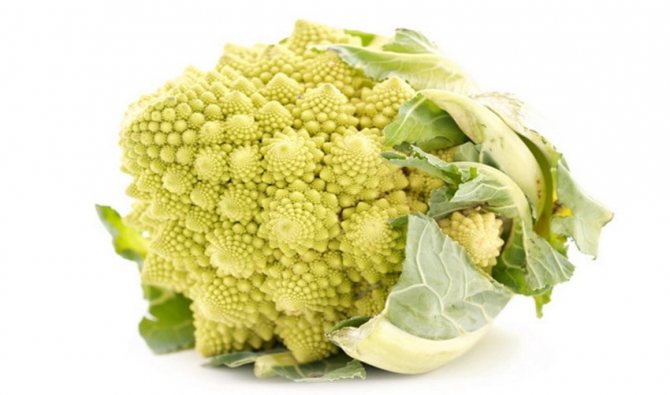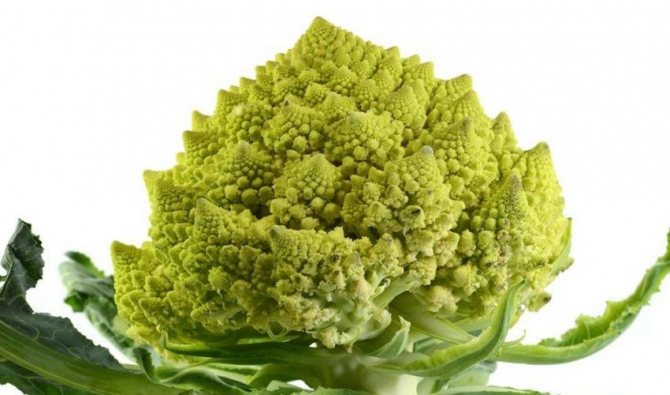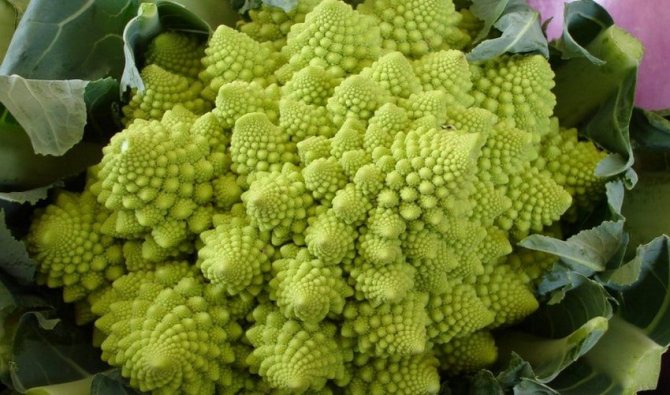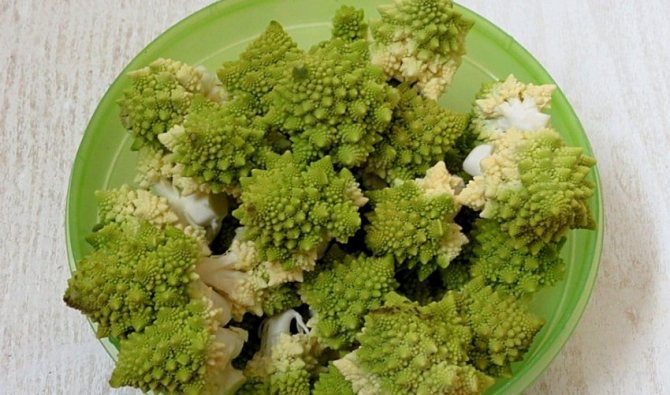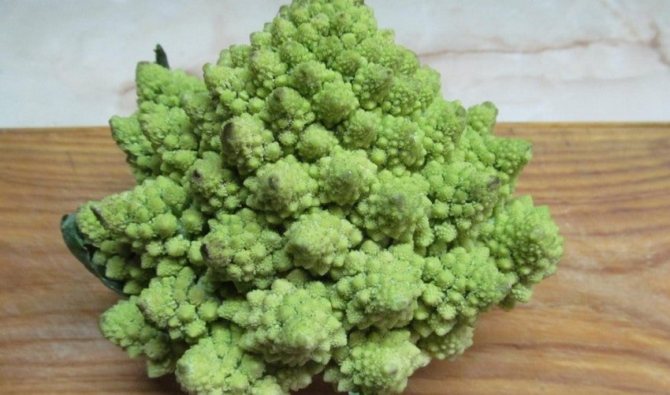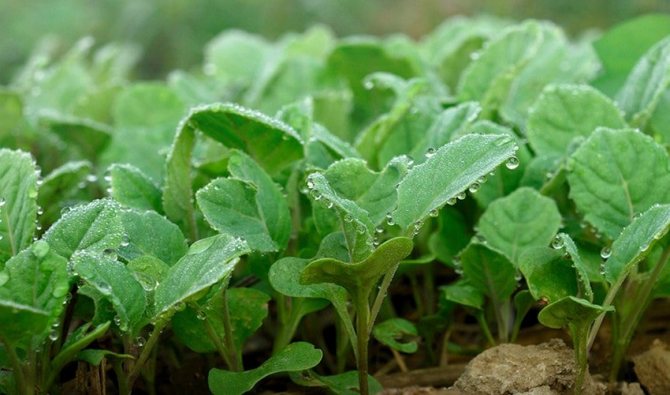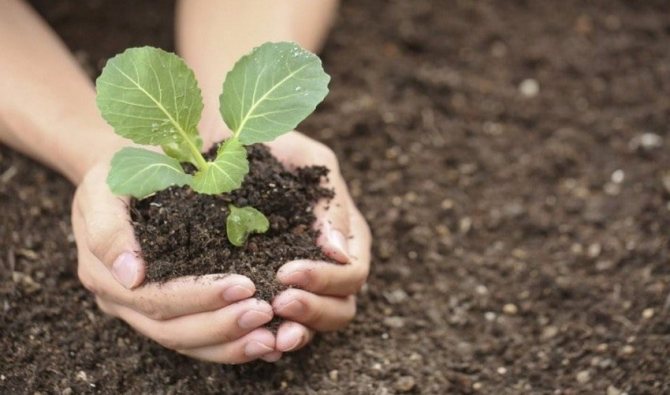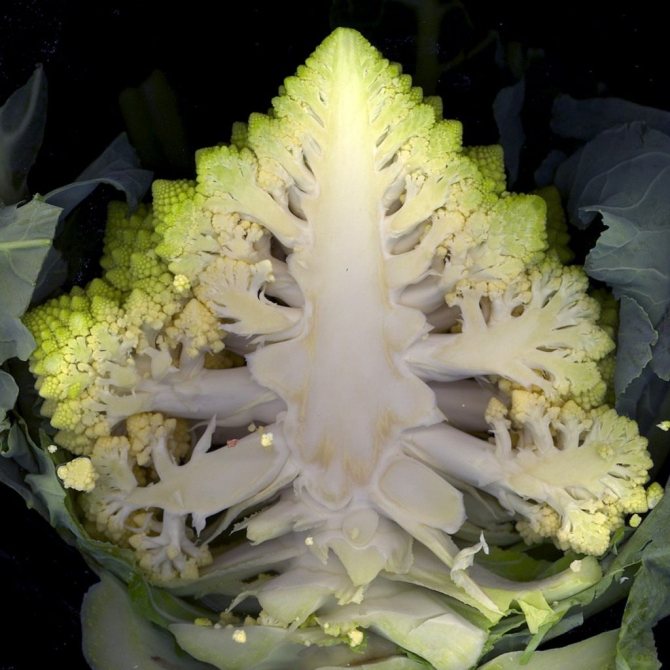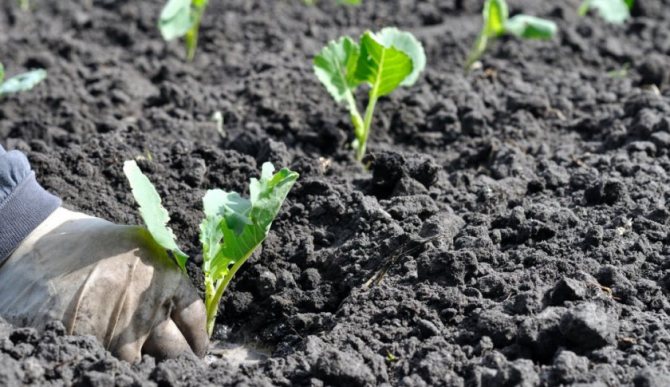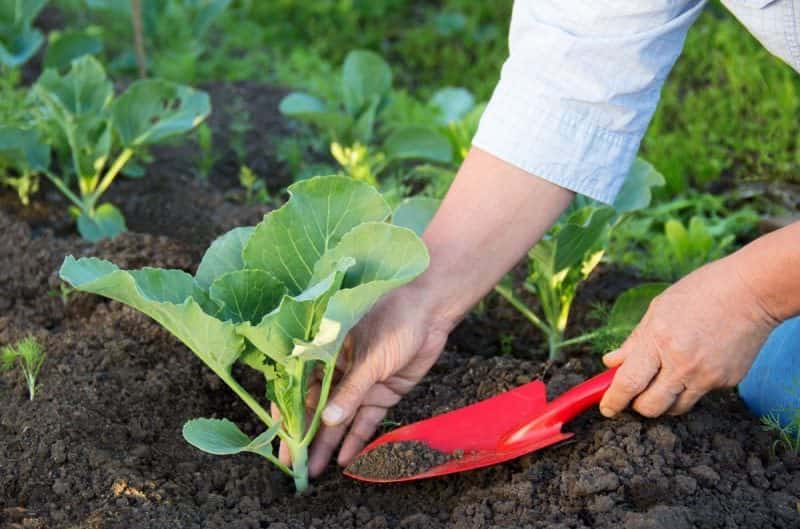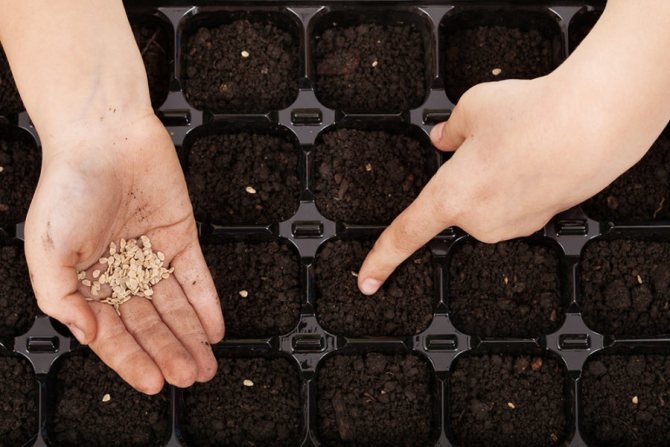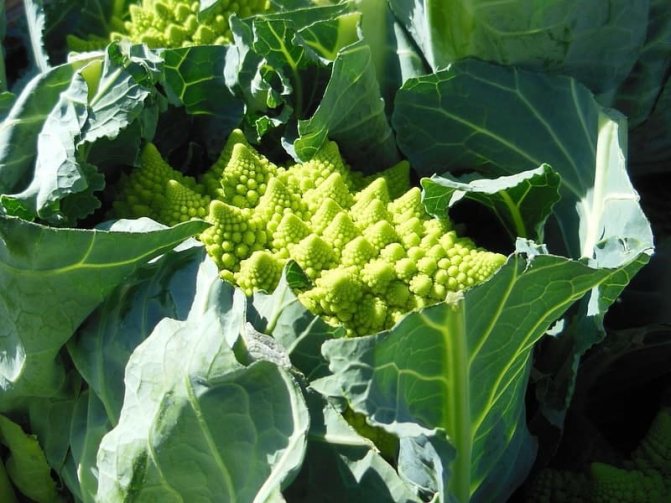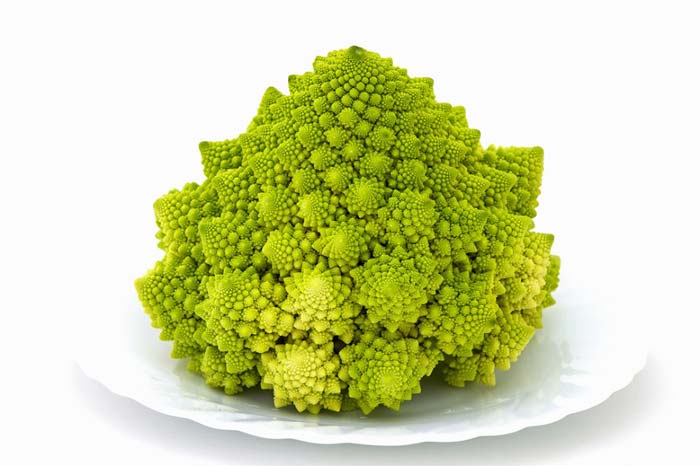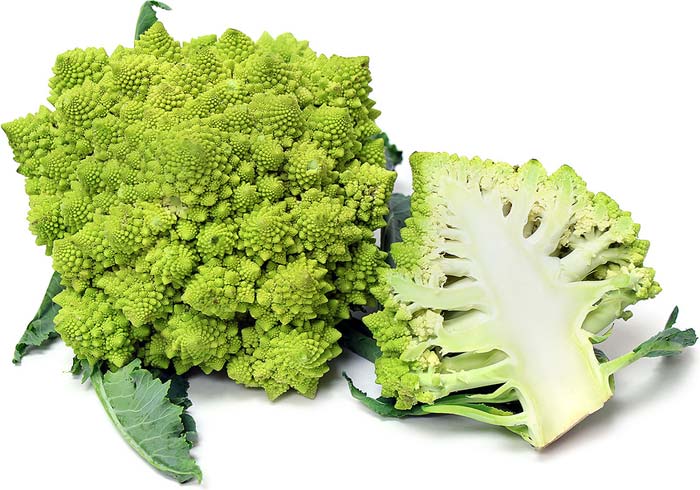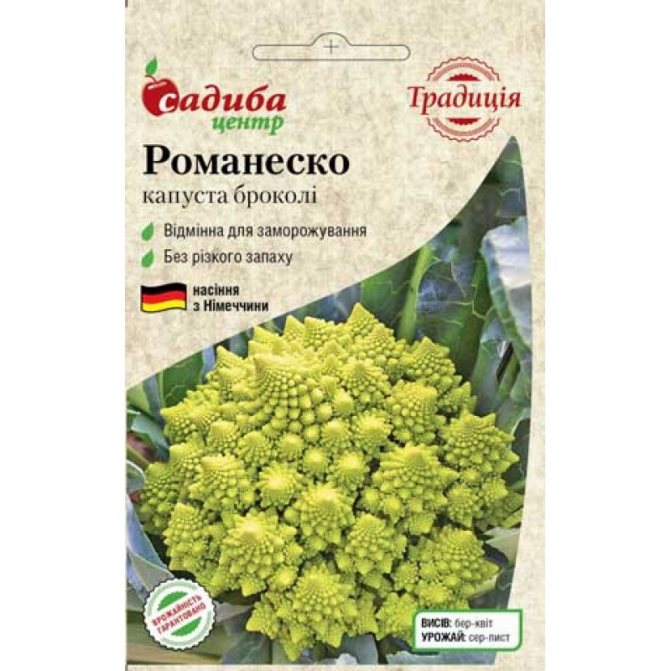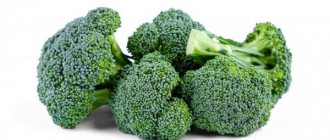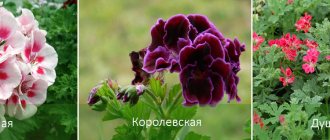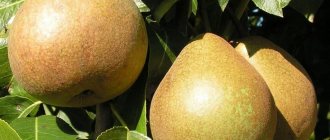Romanesco cabbage is a type of cauliflower that looks unusual and somewhat mysterious. The inflorescences are similar to pyramids, consisting of individual crystals. These pyramids are located exactly in a spiral - from the point of view of geometry, the structure is quite complex. The vegetable belongs to the Cruciferous family, the botrytis varietal group. The second name of this type of cabbage is Roman. Judging by the finds in the cultural layer, the vegetable was grown in the 1st century BC by the Etruscans, and then, already in our era, by the peasants of Tuscany. In the 16th century, it spread throughout Italy, but its popularity soon died out. They noticed it again at the end of the twentieth century, began to import it into all European countries, and then, when they appreciated the taste, they planted it. Roman cabbage tastes sweet and has a delicate structure, so it can be consumed even raw.
What is Romanesco
The culture belongs to the cabbage family. The vegetable was cultivated in Italy, improved in Holland. The head of cabbage consists of light green buds that grow in a spiral and give the plant an alien look. The inflorescences are surrounded by leaves.
They consume only the head of a vegetable crop, it tastes like seaweed. There is no pungent smell and bitterness. The product is sweet with nutty-creamy notes. This cabbage is also called coral, it contains a lot of dietary fiber, minerals and vitamins. Heads of cabbage can be of different sizes and weights. They generally weigh no more than 0.5 kg. The better the care, the larger the cabbage.
Views
There are several main varieties of Romanesco:
- Emerald goblet.
A variety of medium ripening. The weight of the cabbage is approximately 500 g. - Pearl.
Ripening period is medium late, weight - about 800 g. - Puntoverde.
The cabbage is large enough - up to 1.5 kg. This variety is characterized by an average ripening period. - Veronica.
As with the previous version, the ripening time is medium, the weight of cabbage heads is the maximum of all varieties - about 2 kg.
Useful video
A salad with red fish looks interesting and sophisticated. This combination will appeal to any gourmet:
If you find an error, please select a piece of text and press Ctrl + Enter.
Cabbage has many varieties: white and red cabbage forms tight heads of cabbage, kohlrabi, when ripe, becomes similar to turnips, Peking cabbage differs in leaves.
There are types of this vegetable with inflorescences. One of the outlandish types of this vegetable is Romanesco cabbage, the recipes for which are given in this article.
Composition and calorie content
The product is low-calorie, 100 g contains only 30 kcal. Carbohydrates, proteins and fats in the composition of 4.2, 2.5, 0.3 g, respectively. Romanesco contains water, dietary fiber, ash, starch, phytoncides, organic and unsaturated fatty acids.
The vitamin composition is represented by vitamins of group B (B1, 2, 3, 4, 5, 6, 9), A (and its provitamin), E, C, H, K. Of the minerals, the composition contains phosphorus, sodium, zinc, potassium , manganese, magnesium. In addition, cabbage contains iron, copper, selenium, fluoride, calcium.
Characteristics and features
How many days does cabbage emerge after sowing
Fractal cabbage is considered to be an ideal vegetable for maintaining health and beauty.A large amount of vitamins, microelements, delicate fiber, low calorie content are the main advantages of this amazing plant.
100 g of inflorescences (25 kcal in total) contain:
- proteins - 2.9 g;
- fat - 0.4 g;
- carbohydrates - 6.5 g;
- ash - 0.9 g;
- water - 89 g.
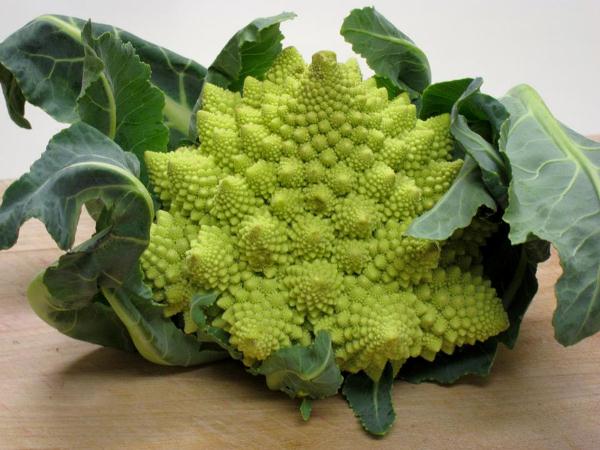
Nice looking
The chemical composition is unique, including, in addition to vitamins and minerals characteristic of any cabbage, folic acid, choline, vitamin H1, selenium, zinc.
Coral cabbage (as it became known for its external resemblance to a colony of polyps) has a positive effect on blood vessels, accelerates metabolism, improves the functioning of the gastrointestinal tract, relieves constipation, hemorrhoids, normalizes blood composition, increases the body's resistance to infections.
Romano is eaten only after heat treatment, it is prepared by analogy with the related cauliflower or broccoli. Gourmets appreciate it for its delicate taste with a nutty note, but without the bitterness characteristic of all crucifers.
The fractal has only two drawbacks:
- Short, up to one and a half weeks, storage of fresh inflorescences without freezing or canning;
- Limitation of use for problems of a cardiological nature, disorders of the thyroid gland.
Useful properties of Romanesco cabbage
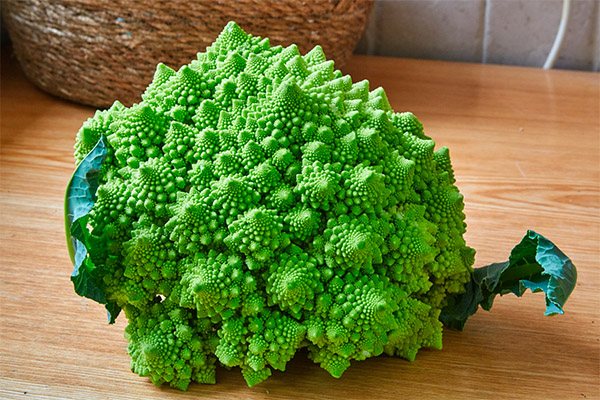

- The vegetable does not cause allergic reactions and helps to get rid of the metallic taste in the mouth, restores the sensitivity of taste buds in case of taste disturbances.
- The product helps to stop the processes of decay and fermentation in the intestines, strengthen teeth and bones, and restore cells in inflammatory processes.
- Cabbage is included in the dietary menu in the fight against obesity.
- Romanesco is also used to maintain the normal functioning of the kidneys, liver, pancreas and thyroid gland.
Doctors recommend including Romanesco cabbage in the diet during the period of gestation, since it contains a lot of folic acid. During pregnancy, the need for high levels of this substance increases. Taking folic acid begins when planning a pregnancy and continues until its completion, additionally consuming foods containing this component.
The beneficial properties are as follows:
- Improving cerebral circulation.
Due to the positive effect on the functioning of the main organ of the central nervous system, more oxygen enters the cells. - Strengthening the heart muscle.
When using the product, the body receives substances important for the heart - vitamins B, K, omega-3. As a result, the heart rate is normalized. - Protection against free radical damage.
The cabbage in question contains antioxidants and fiber. With the introduction of a vegetable into the diet, the risk of developing oncological processes is reduced. - Protection against infectious diseases.
Minerals, vitamins and antioxidants increase the body's defenses to fight harmful microorganisms. - Normalization of sugar levels, elimination of bad cholesterol.
Fiber helps to normalize the level of these substances in the blood. - Improved vision.
Vitamin A contributes to the restoration of a healthy state of the organ of vision. In spiral inflorescences, it is contained in large quantities. With sufficient vitamin levels, macular degeneration in the retina is prevented. - Restoration of disturbed functions of the digestive system.
Dietary fiber in cabbage helps to improve the functioning of the digestive tract and promote the gentle elimination of toxins and heavy metals. - Stimulation of blood circulation.
Iron is directed to activate the production of red blood cells, as a result, a full-fledged process of supplying oxygen to tissues and organs is restored. - Strengthening the nervous system.
The ingredients in the product help fight stress and insomnia.
A powerful vitamin and mineral composition contributes to the development of such effects:
- acceleration of metabolism;
- partial cleansing of the body from harmful cholesterol and toxic substances;
- increasing the elasticity of the vascular walls, strengthening the blood vessels;
- normalization of blood clotting;
- improvement in diarrhea, constipation, hemorrhoids;
- strengthening the nail plate, making hair look healthy;
- restoration of intestinal microflora;
- protection against cancer, atherosclerosis, pathological processes in the lungs;
- inhibition of the formation and development of tumor cells;
- elimination of blood clotting disorders.
If you regularly use Romanesco, the body will be easier to cope with infectious agents. In addition, the process of repairing damaged skin areas will accelerate.
If the child does not have health problems, Romanesco is given in the form of complementary foods from 8 months. Given the attractive appearance of the vegetable, it is likely that in an older age, the baby will eat it with pleasure.
Disease and pest control methods
Many varieties have increased resistance to disease development. But still, a pest or ailment can affect both seedlings and already adult cabbage bushes.
Disease and struggle:
- Mosaic. Yellow spots appear on the foliage. You need to spray the plant with boric acid.
- Blackleg. The stems turn black. The soil and the plant are treated with preparations that contain sulfur.
- Mucous bacteriosis. Watery spots appear on the foliage, leading to rot. Affected leaves are cut off. Cabbage is treated with fungicides.
There are many pests that could feast on tasty and juicy Romanesco. Stems, leaves and inflorescences affects:
- aphid;
- cabbage;
- cabbage fly;
- flea;
- slugs;
- bear.
Such preparations as "Karbofos", "Aktara", "Iskra" and "Karate" will help to protect the heads of cabbage. You can also treat the bushes with ash or soapy water.


Harm and contraindications
Romanesco cabbage does not always benefit the body. When consumed, certain harm is possible for people prone to gas production and prone to diarrhea (with careful introduction of the product into the diet, the problem may not arise). The same goes for people with acute heart disease and serious thyroid problems.
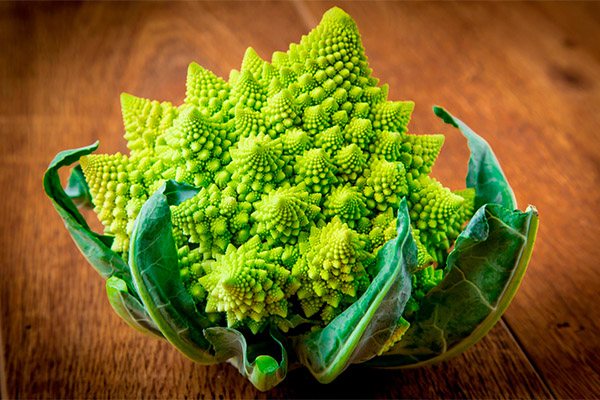

There are a number of contraindications:
- Acute cardiac diseases. It is necessary to discard all foods containing dietary fiber, because they increase the pressure in the vessels.
- Serious disorders in the thyroid gland (possibly worsening of the condition).
- Individual intolerance to the constituents of the product. It is rarely detected, but an allergic reaction can still develop.
- A tendency to disturb the digestive system such as gas, diarrhea, and bloating. In such cases, cabbage can be left in the diet, but not fresh, but cooked. It can be boiled and stewed. Frying is not recommended, since nutrients are destroyed this way.
When consumed excessively, cabbage is harmful even to healthy people. Unpleasant consequences appear in the form of increased gas production, bloating, diarrhea. If such violations are observed even in cases where the product is rarely and in moderation in the diet, it is better to subject it to heat treatment. In addition, for the vegetable to be digested better, you do not need to combine it with fatty meats, legumes, mushrooms.
We advise you to read:
harm and contraindications of savoy cabbage
To read
Beautiful, healthy and tasty
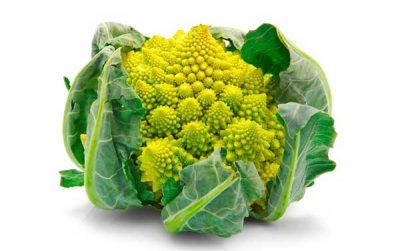

Romanesco is a very unusual vegetable in appearance.
Consists of many inflorescences, folding into one large.
Some connoisseurs of natural beauty grow it not so much for culinary purposes as for aesthetic purposes.
Romanesco has many useful properties: it is rich in vitamins K and C, carotenoids, and is also a source of natural fiber.
Also, the vegetable contains a lot of B vitamins, phosphorus, potassium, selenium, magnesium. This makes cabbage indispensable for a healthy nutrition system.
But that's not all the benefits that can be obtained from the original cabbage. Many (especially those who watch their weight) will surely appreciate its nutritional value. Caloric content is one of the lowest - no more than 30 kcal per 100 g!
Attention! This product is for everyone, there are practically no contraindications. The only possible harm is bloating and flatulence, which occur solely from excessiveness. ... Romanesco comes from Italy, the description of a similar vegetable is very old, although it was in this form that the variety became popular at the end of the last century.
The name itself is translated as roman cabbage. Italian housewives practice unusual ways of cooking this vegetable. And in the rest of the world, where Romanesco is represented on the vegetable markets, they use any recipe for making broccoli.
Romanesco comes from Italy, the description of a similar vegetable is very old, although it was in this form that the variety became popular at the end of the last century. The name itself translates as roman cabbage. Italian housewives practice unusual ways of cooking this vegetable. And in the rest of the world, where Romanesco is represented on the vegetable markets, they use any recipe for making broccoli.
How to choose and store
Going to the store or the market, you need to carefully examine the cabbage:
- The selected fruit must not be deformed. The shape is pyramidal, there are no damages or bumps.
- The leaves are fresh, not twisted at the cut, there are no spots.
- The surface of the fruit is not covered with snow powder or crushed ice.
Romanesco can be purchased not only fresh, but also canned. It should be borne in mind that after harvesting, the vegetable cannot be stored in the refrigerator for a long time, because it deteriorates quickly. But it can be frozen, and then all the nutrients will be preserved. Thanks to deep freezing, healthy cabbage can be consumed at any time of the year.
Advantages and disadvantages of the variety
- Speaking of the benefits of coral cabbage, it should be noted:
- The uniqueness of the composition, which allows you to support the body in various painful conditions.
- Low calorie content of the product and at the same time its increased nutritional value.
- Easy to prepare.
- Delicacy of taste, no bitterness; lack of rigid fibers.
- Attractiveness of appearance and the possibility of using it in external decor.
- But the main disadvantages of roman cabbage are:
- Whimsical care and the need to strictly follow all the rules of cultivation, which makes it extremely difficult to grow.
- Fresh cabbage has a short shelf life - no more than a week in the refrigerator.
How to cook Romanesco cabbage: recipes
This type of cabbage is widely used in cooking. It is stewed, baked, boiled, fried (but not for long and with the addition of a small amount of oil), grilled and steamed. An unusual vegetable is consumed separately and used to prepare casseroles, salads, snacks, side dishes, soups. Thanks to the addition of an ingredient such as Romanesco, the dishes are given a pleasant creamy nutty flavor.
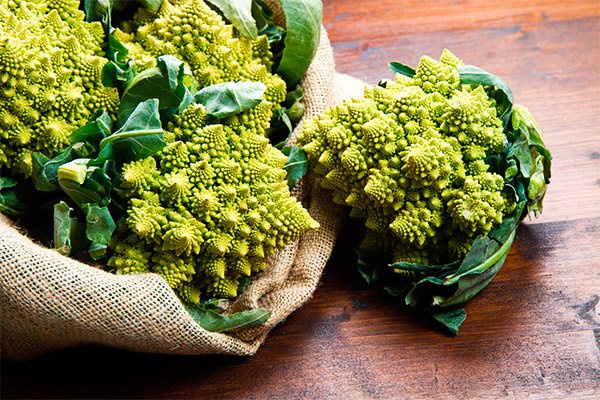

Cabbage is combined with seafood, fish, lean meat (turkey, chicken fillet), other vegetables and is used as an original decoration. It is supplemented by sources of complex carbohydrates (buckwheat, whole grain pasta, quinoa, brown rice). The vegetable is prepared in the same way as cauliflower, but it is easier to digest. There are many recipes for preparing Romanesco as an independent dish with a peculiar taste.
Cabbage salad
Ingredients:
- cabbage - head of cabbage;
- turkey meat (fillet) - 300 g;
- carrots, onions, bell peppers - 1 pc.;
- garlic - 1 clove.
Preparation:
- The fillet is cut and sent to the pan. Small pieces of turkey meat are cooked with minimal heating of the stove using the stewing method.
- The meat is stewed for 15 minutes, chopped vegetables are added during the preparation of the ingredient.
- In parallel, for 15 minutes (no longer, otherwise the vegetable will fall apart) Romanesco is boiled in salt water. The cabbage should be soft while remaining firm. Then it is cooled and disassembled into inflorescences.
- Combine all products, add salt and pepper to them to taste, mix. Garlic is the last to be added to the salad.
Romanesco omelet
The dish is hearty and healthy, it prepares quickly. This is a great breakfast option. The main thing is to prepare mushrooms and cabbage in the evening.
Ingredients:
- cabbage - 150 g;
- cheese - 50 g;
- mushrooms - 3-5 pcs.;
- eggs - 4 pcs.;
- tomatoes - 2 pcs.;
- flour - 1 tablespoon;
- onion - half;
- soy sauce and spices to taste.
Preparation:
- Cabbage is sorted into inflorescences and boiled in salted water for 5 minutes.
- Mushrooms are scalded with boiling water. This recipe uses champignons (oyster mushrooms, too, just need to scald), but you can take other mushrooms and boil them for 15 minutes.
- The cooled mushrooms are cut into plates, the onion is chopped into cubes, the tomatoes are cut into slices.
- Beat the eggs, then add spices, flour, cheese and mix until smooth.
- Lightly fried onions are mixed with tomatoes and kept on the stove until the liquid evaporates.
- Mushrooms and cabbage are poured into the pan. The ingredients are mixed.
- After 1 minute, pour out the eggs and bring them to readiness with minimal heating (it takes about 7 minutes).
Soup-puree
Ingredients:
- Romanesco - 1 head of cabbage;
- carrots, potatoes, onion, bell pepper - 1 pc.
Preparation:
- The cabbage is boiled, the cooled product is divided into parts. Water is not poured out, it will still come in handy.
- The rest of the vegetables are peeled and diced. Combine with Romanesco and pour into a saucepan with a thick bottom, where vegetable oil was previously poured. The contents of the pan are sautéed with minimal heat.
- Cabbage water is added to the vegetables, they are cooked for 10 minutes.
- Using a blender, the contents of the pan are mashed.
Video:
recipe for salad with romanesco cabbage Expand
Inflorescences in batter
The cabbage turns out to be soft and tender on the inside, and a crispy crust forms on top. It is cooked in a lot of oil. The dish is high-calorie, but tasty.
Ingredients:
- cabbage - 1 head of cabbage;
- flour - 3 tablespoons;
- eggs - 3 pcs.;
- spice.
Preparation:
- Cabbage inflorescences are boiled for 4 minutes, then they are transferred to ice water.
- Prepare batter. The remaining ingredients are mixed until smooth.
- A lot of oil is poured into a deep frying pan and heated, only after this action they begin to fry the product.
- The cabbage is dipped in batter and sent to the pan for 20-30 seconds. To get rid of excess fat, put the finished product in a colander.
This cabbage can be used with mashed potatoes, boiled rice. This is a good side dish for meat.
Coral cabbage baked with cheese
Ingredients:
- head of cabbage;
- flour - 2 tablespoons ;
- butter - 30 g;
- milk - 1 tbsp.;
- vegetable oil for greasing the baking sheet;
- herbs to taste;
- grated cheese to form a golden crust.
Preparation:
- The inflorescences are dipped in salted boiling water for 10 minutes.
- Heat oil in a frying pan, then add flour and fry it for about 1 minute.
- Milk is poured in small portions, constantly stirring the mixture. If the sauce is not mixed, lumps will form.
- A sufficient amount of vegetable oil is poured onto a baking sheet and distributed over the entire area.
- Spread boiled cabbage, add sauce, then herbs and cheese. Prepare the dish until an appetizing crust appears.
Healthy vegetable salad
The main thing is to choose a quality product. It should be firm, greenish in color, without black spots. To make the salad as healthy as possible, it is recommended to use vegetable oil as a dressing.It can be mixed with additional ingredients like lemon juice, spices, mustard.
Ingredients:
- cabbage - 1 small head of cabbage;
- bulgarian pepper, tomato - 1 pc.;
- daikon - 150 g;
- lemon ring;
- vegetable oil - 1-2 tablespoons;
- lemon juice - 1 tablespoon;
- mustard beans - 3 tablespoons;
- dill - about 6 branches;
- pepper, salt.
Preparation:
- The inflorescences are boiled in boiling water, to which a lemon has been added (one ring). Depending on their size, they are boiled for 3-5 minutes.
- The cabbage is thrown in a colander and kept under cold running water until it cools.
- Before adding the ingredient to the salad, dry it with napkins.
- Start making the sauce. For these purposes, take a deep bowl. Combine juice, oil, mustard.
- Peel the daikon and cut it into thin strips, send it to a bowl with cabbage.
- Pepper is peeled from seeds and also cut into strips. Do the same with a tomato. Pour the food into a bowl. Chopped greens are also added there. You can use not only dill, but also celery, basil, parsley.
- The dish is pepper, salted to taste, mixed with the dressing. They eat it immediately after cooking, because the taste deteriorates during storage.
Romanesco roasted in the oven with milk and cheese
This recipe can be used to make a hearty yet light meal.
Ingredients:
- head of cabbage - 1 pc .;
- hard cheese - 100 g;
- milk - 250 ml;
- flour - 2 tablespoons;
- Italian herbs and salt to taste.
Preparation:
- The head of cabbage, boiled for 10 minutes, is disassembled into inflorescences. You can boil the product immediately in the form of inflorescences, reducing the cooking time to 5 minutes.
- Pour flour into a dry frying pan and bring it to a golden color.
- Milk is poured in a stream, mixing the contents of the pan thoroughly so that there are no lumps.
- Grated hard cheese is poured into a homogeneous mixture. The sauce is stirred until the cheese is completely melted and mixed with the herbs.
- The cabbage is placed in a mold, the sauce is evenly distributed.
- The dish is cooked for about 15 minutes at the highest possible temperature.
We advise you to read:
how to cook broccoli cabbage deliciously
To read
Capers, Romanesco, Brussels sprouts and cauliflower appetizer
The recipe is for 6 servings. Season the ingredients with mustard oil.
Ingredients:
- Brussels sprouts - 350 g;
- color, Romanesco - 150 g each;
- lemon - 1 fruit;
- butter - 4.5 tablespoons;
- marjoram - 2.5 tablespoons;
- capers - 1.5 tablespoons;
- mustard beans - 1.5 tsp;
- pepper, sea salt - to taste;
- garlic (cloves) - 1.5 pcs.
Preparation:
- Garlic is thoroughly ground with salt, mixed with capers, softened butter, pepper, mustard, marjoram, lemon zest.
- At heads of cabbage, the lower part is cut off. The cabbage itself is cut into pieces, focusing on its size.
- Water is poured into a saucepan, salted and brought to a boil. First of all, they throw in Brussels sprouts, after 3 minutes - the rest of its types. After 5 minutes, the vegetables are removed from the water.
- All components are mixed with the oil obtained in the first stage.
Romanesco in sabayon sauce
Cabbage of this type is delicious in itself, the egg-lemon sauce only emphasizes the taste of the vegetable and makes it even more unusual.
Ingredients:
- cabbage - 0.5 kg;
- lemon - 1 fruit;
- yolks - 6 pcs.;
- almonds - 5 nuts;
- wine (white) - 1 tbsp.;
- sugar - 2 tablespoons;
- salt to taste.
Preparation:
- Coral cabbage inflorescences are steamed for 7 minutes.
- While the main ingredient is being prepared, knead the sauce. To do this, combine the yolks, lemon zest from half of the fruit and sugar.
- In order for the vegetable to retain its color, the container with cabbage is sent under cold water.
- Put the sauce in a water bath, stir it constantly. Then squeeze the juice from half a lemon into a saucepan and pour in the wine. With minimal heating, whisk the contents of the container with a whisk.
- To make the sauce airy, beat it with a blender after thickening.
- Salted cabbage, spread sauce and almonds.
Can Romanesco cabbage be eaten raw
Romanesco does not have to be cooked, it can be eaten raw. This cabbage is so beautiful that it is even a pity to cook it. Raw product is crispy with a nutty flavor. Cabbage is used with various sauces, it can be either meat or cream sauce or any other.
Growing history
Biologists and specialists in the exact sciences have published many works devoted to Romanesco cabbage, but there is still no definite answer not only to the question of the origin of this vegetable, but also to the degree of relationship between Romanesco and all known types of cabbage. There is a version that Romanesco is a hybrid of cauliflower and broccoli, but no strict confirmation of its truth can be found in serious biological literature..
Growers are careful to refer to Romanesco cabbage as subspecies or varieties of cauliflower. There is a certain duality in these definitions: it is not entirely colored, and it seems that it is not a hybrid.
Scientists-mathematicians, having devoted many works to the description of the Romanesco fruit through complex equations, put forward the theory that this culture was born quite recently, only at the end of the 20th century. The spiral shape of the inflorescences, which obeys well logarithmic equations, gives rise to such assumptions. Therefore, they say, not only breeders, but also 3D designers took part in the creation of cabbage, introducing some cunning genes into cabbage. This vegetable of bright light green color looks rather strange, but at the same time it is very beautiful.
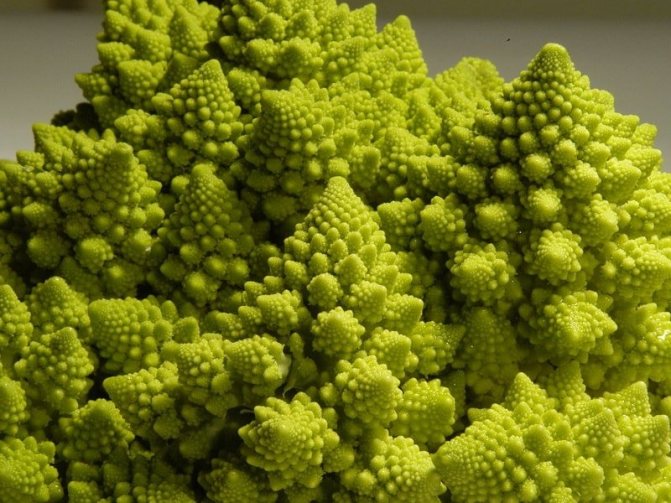

A set of unusual spiral Christmas trees evokes memories that once the whole country wanted to fly into space
However, such theories are shattered by historians who claim that this cabbage was known even before our era, when it was grown by the Etruscans. They allegedly brought Romanesco to Tuscany, from where it spread further. More cautious researchers believe that this cabbage has been known only since the 16th century, but, one way or another, its widespread distribution began about 100 years ago.
The fact that the cabbage is from Italy is confirmed by its name: romanesco means "Roman". Its other famous names are coral cabbage, Romanesque broccoli.
Of course, broccoli and cauliflower had the opportunity to get dusty in the wild without human intervention, but authoritative sources do not confirm this version. Well, the assumptions about an extraterrestrial origin (appearing on the basis of the correct shape of the inflorescences) seem fantastic at all. There is even a version that Romanesco came to us on Earth, falling out of an unidentified flying object.
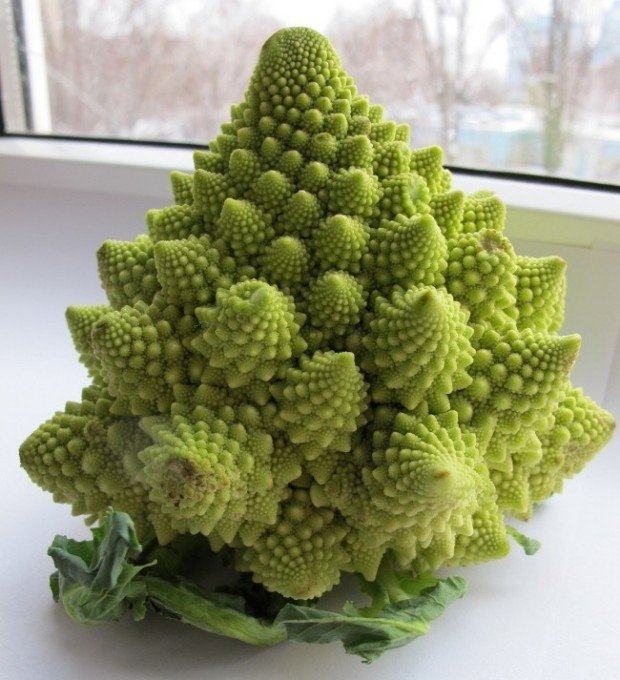

Romanesco without leaves resembles a space tree
The shape of this cabbage is compared to both a set of pyramids and a giant shell, but all those who have tried dishes from it describe them as delicious, tender, without a strong smell and bitter taste. Compared to the well-known varieties of cauliflower, Romanesco is somewhat sweeter. Its stems are softer than broccoli. Romanesco is easy to cook and is also suitable for making salads, although gourmets say that it is not worth eating raw.
How to grow Romanesco cabbage
Romanesco cabbage is grown in much the same way as cauliflower. For planting, they choose a site where potatoes were grown and where enough sunlight comes in. This moment is associated with one important feature - after potatoes, the soil remains loose. It is undesirable that the predecessors were representatives of cabbage, because their diseases can be transmitted to new plants, it is possible to be affected by the same pests.
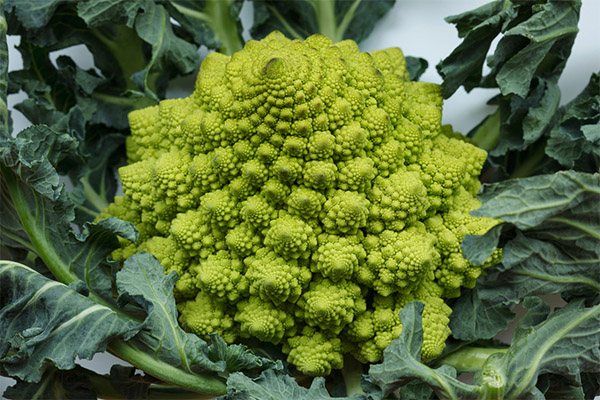

The soil should not be acidic. The best option is alkaline soil. Before planting seedlings, the beds are treated with lime or wood ash (200-400 g are used per 1 square meter). You can apply compost. It is important that there is enough moisture in the soil, therefore watering should be regular.It is especially important to observe this rule when forming inflorescences.
To get seedlings, seeds must be planted around the last days of April. The room is kept at the optimum temperature, the maximum possible value is + 20 ° C. When seedlings are already observed (the process of their formation lasts about 24–28 days), it is reduced. It is necessary to maintain + 8 ° С at night, + 10 ° С during the day. You can get such values by moving the boxes, for example, to the balcony. During the period of growing seedlings, the level of lighting is monitored to prevent the process of pulling the stems too quickly.
They are planted in the ground after severe spring frosts, not earlier, that is, about 1.5–2 months after sowing. But still, when planting plants in open ground, one should be guided by the peculiarities of the local climate. Mistakes can lead to the absence of full-fledged inflorescences. In order for them to tie properly, the temperature should be approximately +17 to + 18 ° C. A distance of 60x60 cm is observed between plants and rows.
Germination rate is less than 100%, therefore seeds are used in an amount of 3 pieces. (large and small). Harvesting is carried out in early autumn. Heads of cabbage are recommended to be cut in the morning, when they have not yet had time to warm up in the sun. They should not be overexposed, as the inflorescences can dry out and begin to rot.
Video:
how to grow Romanesco cabbage Expand
Plant care
The rules for caring for coral cabbage are generally the same as for ordinary garden crops, but they require rigor in implementation.
Watering and feeding
Romanesco does not tolerate waterlogging of the soil, so watering should be regular and sufficient, but moderate. Ideal is the use of a drip irrigation system.
If there is none, you need to adhere to the following watering rules:
- At the initial stage of growth - twice a week.
- Further watering is weekly.
- Water consumption: first, for 1 m² of the garden - a bucket of water, with the growth of bushes - more (determined empirically).
- The temperature of the water does not matter much: you can use both warm and cold.
- It is better to water at the root. With the tying of the heads - only at the root.
Did you know? The most common cauliflower color is white, but there are also green, purple, orange, brown and yellow cauliflowers.
Loosening the soil
This procedure is done after watering or rain, until leaves close between adjacent plants. Loosening is carried out together with weeding. It is also useful at this time and hilling with the introduction of wood ash into the soil.
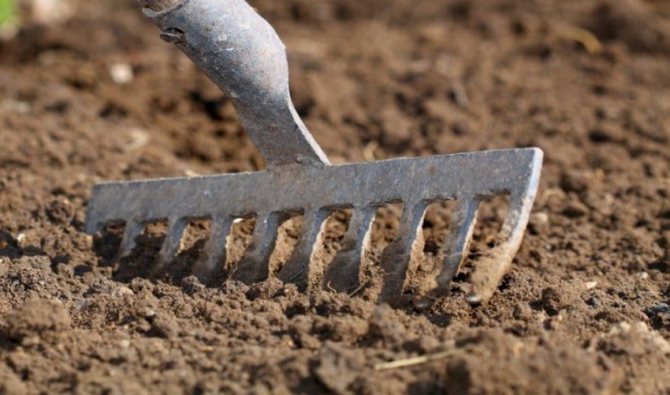

Pests and diseases
Romanesco cabbage is susceptible to the same ailments and attacks of the same harmful insects as common cauliflower.
Diseases:
- Slimy bacteriosis or "wet bacterial rot". Signs of damage: emerged watery spots on the leaves and flowers, which quickly grow and rot. Preventive measures: disinfection of seeds before planting by keeping them for 2-3 hours in a light solution of potassium permanganate, as well as disinfection of sowing containers. Methods of treatment: removing the stains that have arisen with a sharp knife, if it does not help, removing the affected bush from the garden bed, followed by burning it.
- Blackleg. The disease occurs at the stage of growing seedlings. Signs of damage: blackening of the stem base and the subsequent appearance of a brown tint on it. Preventive measures: correct watering, excluding waterlogging of the soil, disinfection of the soil. Treatment methods: disinfection, steaming and soil replacement; treatment of plants and substrate with preparations of the sulfur group.
- Mosaic. Viral infection. Signs of damage: the appearance of randomly located yellowish veins on the leaves. Preventive measures: timely destruction of weeds and harmful insects in the garden.Methods of treatment: treatment of the plant with Bordeaux liquid, if it does not help - removal of the affected bush from the garden, followed by burning.
Important! Mint, celery or dill planted next to Romanesco will help in the fight against harmful insects.
Pests:
- Cabbage aphid. Signs of damage: slow plant growth; the leaves lose their normal color, the acquisition of a pink tint; gradual twisting and death of leaves. Prevention: regular watering. Fighting: treatment with insecticidal preparations such as "Karbofos", "Iskra", "Karate".
- Cruciferous fleas. Signs of damage: ulcers on the upper layers of the leaves. Struggle: treatment with soap solution; a composition of road dust and wood ash; the use of drugs "Karbofos", "Aktara".
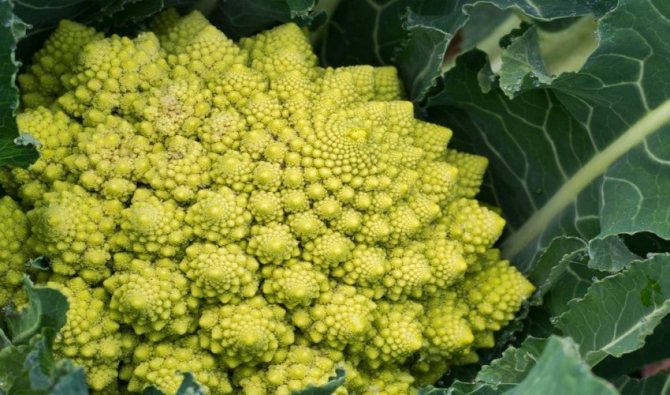

Agricultural technology of Italian cabbage
Agricultural technology "Italian" is almost the same as that of white cabbage. It is also grown through seedlings, but only here there is one small caveat. For about a week before planting on the beds, young plants are not watered, only on the day of planting they carry out abundant watering.
Cabbage is sown from March 15 to April 20, it will be possible to harvest early maturing varieties in July. Seeds germinate at 3 ° C, but 16-18 ° C is considered optimal for growth. A sharp cold snap to 8 ° C slows down the development of seedlings, but does not stop the process.
They are planted on a garden bed in early May, observing an interval between plants of 50 cm × 50 cm or 40 cm with a row spacing of 60 cm. By this time, the seedlings have 5 or more leaves. It is buried down to the cotyledons, well spilled. Experienced gardeners sow early maturing varieties directly into the ground until May 25.
- Care and cleaning
After 10 days, it is advisable to fertilize the planting: half a liter of mullein and 15 g of urea are diluted in a bucket of water. Consumption per plant - 0.7 l of fertilizer. After planting, cabbage is huddled twice: the first - after 20 days, the second - after 10 days.
The following top dressing is done during the formation of heads: for a bucket of water, half a liter of mullein, 50 g of nitrophoska. Consumption per plant - 1.5 liters of nutrient solution. Between top dressing and hilling, do not forget about weeding the beds from weeds and watering, because the Savoyard “lace maker” loves moisture very much.
Overripe heads of cabbage are prone to cracking, so they are harvested at the stage of technical ripeness. To prevent cabbage heads from contamination, bruises, two or three outer green leaves are left. Due to the poor keeping quality, Italian cabbage for winter storage is harvested in October along with the roots and dropped into the cellar or basement. So it can be stored for up to 5 months.

